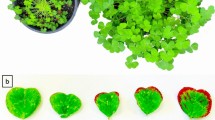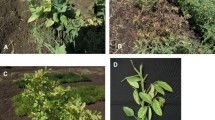Abstract
Seventy one seed-lines representing 23 species of papilionoid legumes and 17 species of nonlegumes were collected and distributed to four countries; Australia, New Zealand, the Netherlands and the U.S.A. In each of these countries plants were grown from the seeds and their susceptibility to a total of eight persistent aphid isolates transmitted viruses was assessed. The viruses were a strain of beet western yellows (BWYV) fromGlycine max in Illinois, legume yellows (LYV) in California and a virus in Michigan (MiAV) fromMedicago sativa, fromPisum sativum causing leaf roll and top yellows in New Zealand (PeLRV-NZ) and the Netherlands (BLRV), isolates of subterranean clover red leaf from New Zealand (SCRLV-NZ) and Tasmania (SCRLV-T), and subterranean clover stunt (SCSV) from Tasmania.
The relationships between the eight viruses as indicated by their host reactions were assessed using computer classification techniques. SCRLV-NZ and SCRLV-T were the most similar. They had moderately wide host ranges that included some non-legumes. A second group comprized BWYV and PeLRV-NZ. These were typical of most beet western yellows virus strains in that they infectedBrassica napus, Capsella bursa-pastoris andStellaria media. MiAV and BLRV also formed a pair. They generally induced severe symptoms on the hosts which they infected and had host ranges confined to legumes except that BLRV also infectedClaytonia perfoliata andErodium spp. The relationships of LYV and SCSV were not consistent. They paired together in some classifications, but SCSV sometimes grouped with the SCRLV isolates. Both had host ranges confined to legumes, caused severe symptoms in most hosts and were often difficult to recover from affected plants. LYV had some affinities with BLRV and MiAV.
The tests indicated a set of test plants which were most useful for propagating and identifying persistent aphid-transmitted viruses from legumes. Two,P. sativum cv. Onyx andTrifolium subterraneum cv. Bacchus Marsh were susceptible to all isolates. Ten others distinguished between the isolates and wereArachis hypogea, Beta vulgaris, C. bursa-pastoris, G. max cv. Shirotsurunoko,Gomphrena globosa, Lactuca sativa, Lens esculenta cv. 179307,M. sativa cv. Washoe,Phaseolus vulgaris cv. Canadian Wonder andTrifolium hybridum.
Samenvatting
Eenenzeventig zaadmonsters van 23 soorten van de Papilionaceae en 17 andere soorten werden verzameld en naar laboratoria in Australië, Nieuw Zeeland, Nederland en de Verenigde Staten van Amerika gezonden. In elk van deze landen werden de uit de zaden verkregen planten op hun vatbaarheid voor acht door bladluizen op persistente wijze overgebrachte virussen getoetst. Het betrof de volgende virussen: ‘beet western yellows virus’ (BWYV) vanGlycine max uit Illinois, ‘legume yellows virus’ (LYV) uit Californië, een virus vanMedicago sativa uit Michigan (MiAV), twee virussen die bladrol en topvergeling inPisum sativum veroorzaken, één uit Nieuw Zeeland (PeLRV-NZ) en één uit Nederland (BLRV), isolaten van het ‘subterranean clover red leaf virus’ uit Nieuw Zeeland (SCRLV-NZ) en Tasmanië (SCRLV-T) en ‘subterranean clover stunt virus’ (SCSV).
De verwantschap tussen de acht genoemde virussen, zoals blijkend uit de reacties van de verschillende waardplanten, werd vastgesteld met behulp van een computerprogramma voor classificatie.
SCRLV-NZ en SCRLV-T vertoonden de meeste verwantschap. Beide hadden een tamelijk grote waardplantenreeks, waaronder enkele soorten die niet behoorden tot de vlinderbloemigen.
BMYV en PeLRV-NZ vormden een tweede groep. Zij waren typisch voor de meeste stammen van het ‘beet western yellows virus’ in zoverre zij de toetsplantenBrassica napus, Capsella bursa-pastoris enStellaria media konden infecteren.
MiAV en BLRV vormden eveneens een paar. Zij veroorzaakten meestal verschillende typen symptomen op de vatbare waardplanten. De waardplantenreeks was beperkt tot de Leguminosae. Alleen kon BLRV ookClaytonia perfoliata enErodium spp. infecteren.
De mate van verwantschap tussen LYV en SCSV was niet eenduidig. Uit bepaalde eigenschappen zou tot onderlinge verwandtschap besloten kunnen worden, uit enkele andere echter zou meer een verwantschap tussen SCSV en SCRLV worden vermoed. De waardplantenreeks van LYV en SCSV was beperkt tot de Leguminosae; beide veroorzaakten hevige symptomen in hun waardplanten en konden moeilijk worden geïsoleerd uit geïnfecteerde planten. LYV vertoonde enige verwantschap met BLRV en MiAV.
Op grond van de resultaten van de proeven kon een groep van toetsplanten worden samengesteld, die zeer bruikbaar is voor de virusvermeerdering en voor de identificatie van de genoemde acht virussen. Twee van de toetsplanten, nl.P. sativum enTrifolium subterraneum cv. Bacchus Marsh bleken vatbaar voor alle isolaten. Tien andere, nl.Arachis hypogea, Beta vulgaris, C. bursa-pastoris, G. max cv. Shirotsurunko,Gomphrena globosa, lactuca sativa, Lens esculenta cv. 179307,M. sativa cv. Washoe,Phaseolus vulgaris cv. Canadian Wonder enTrifolium hybridum zijn geschikt voor onderscheiding van alle genoemde isolaten.
Similar content being viewed by others
References
Ashby, J.W. & Huttinga, H., 1979. Purification and some properties of pea leafroll virus. Neth. J. Pl. Path. 85: 113–123.
Ashby, J.W. & Johnstone, G.R., 1984. Report on legume luteovirus taxonomy and current research. Australasian Plant Pathology 13: (in press).
Ashby, J.W. & Kyriakou, A., 1982. Purification and properties of subterranean clover red leaf virus. N.Z. Jl agric. Res. 25: 607–612,
Ashby, J.W., Teh. P.B. & Close, R.C., 1979. Symptomatology of subterranean clover red leaf virus and its incidence in some legume crops, weed hosts, and certain alate aphids in Canterbury, New Zealand. N.Z. Jl agric. Res. 22: 361–365.
Baker, K.F., 1957. The U.C. system for producing healthy container-grown plants. California Agriculture Experiment Station Extension Service, Manual 23.
Burr, E.J., 1968. Cluster sorting with mixed character types. 1. Standardization of character values. Aust. Comput. J. 1: 97–99.
Casper, R., Meyer, S., Lesemann, D-E., Reddy, D.V.D., Rajeshwari, R., Misari, S.M. & Subbarayudu, S.S., 1983. Detection of a luteovirus in groundnut rosette diseased groundnts (Arachis hypogea) by enzyme-linked immunosorbent asay and immunoelectron microscopy. Phytopath. Z. 108: 12–17.
Dallwitz, M.J., 1974. A flexible program for generating identification keys. Syst. Zool. 23: 50–57.
Duffus, J.E., 1972. Beet western yellows virus. CMI/AAB. Descriptions of Plant Viruses No. 89.
Duffus, J.E., 1977. Aphids, viruses and the yellow plague. In: Harris, K.F. & Maramorosch, K. (Eds), Aphids as virus vectors, Academic Press, New York, p. 361–383.
Duffus, J.E., 1979. Legume yellows virus, a new persistent aphid-transmitted virus of legumes in California. Phytopathology 69: 217–221.
Duffus, J.E. & Johnstone, G.R., 1982. The probable long association of beet western yellows virus with the potato leaf roll syndrome in Tasmania. Aust. J. exp. Agric. Anim. Husb. 22: 353–356.
Duffus, J.E. & Milbrath, G.M., 1978. Natural occurrences and distribution of beet western yellows virus in soybean. Am. phytopath. Soc. phytopath. News 12: 170 (Abstr.).
Fenner, F., 1976. Classification and nomenclature of viruses. Second report of the International Committee on Taxonomy of Viruses. Intervirology 7: 1–116.
Gibbs, A. & Watson, L., 1980. Viruses and legumes. In: Summerfield, R.J. & Bunting, A.H. (Eds). Advances in legume science, Min. of Agric. Fish. & Food, H.M.S.O., London, p. 235–241.
Gower, J.C., 1966. Some distance properties of latent-root and vector methods used in multivariate analysis. Biometrika 53: 325–388.
Hampton, R.O., 1983. Pea leaf roll in northwestern U.S.A. pea seed prodution areas. Pl. Dis. 67: 1306–1310.
Hull, R. & Adams, A.N., 1968. Groundnut rosette and its assistor virus. Ann. appl. Biol. 62: 139–145.
Inouye, T., Inouye, N. & Mitsuhata, K., 1968. Yellow dwarf of pea and broad bean caused by milk vetch dwarf virus. Ann. phytopath. Soc. Japan 34: 28–35.
Iwaki, M., Roechan, M., Hibino, H., Tochihara, H. & Tantera, D.M., 1980. A persistent aphidborne virus of soybean, Indonesian soybean dwarf virus. Pl. Dis. 64: 1027–1030.
Johnstone, G.R., 1978. Diseases of broad bean (Vicia faba L.major) and green pea (Pisum) sativum L.) in Tasmania caused by subterranean clover red leaf virus. Aust. J. agric. Res. 29: 1003–1010.
Johnstone, G.R. & Duffus, J.E., 1984. Some luteovirus diseases in Tasmania caused by beet western yellows and subterranean clover red leaf viruses. Aust. J. agric. Res. 35: (in press).
Johnstone, G.R., Duffus, J.E., Munro, D. & Ashby, J.W., 1982. Purification of a Tasmanian isolate of subterranean clover red leaf virus, and its serological interactions with a New Zealand isolate and other luteoviruses. Aust. J. agric. Res. 33: 697–703.
Kyriakou, A., Close, R.C. & Ashby, J.W., 1983. A strain of beet western yellows virus in Canterbury, New Zealand. N.Z. Jl agric. Res. 26: 271–277.
Lance, G.N. & Williams, W.T., 1966. A generalized sorting strategy for computer classifications. Nature 212: 218.
Lance, G.N. & Williams, W.T., 1967. Mixed-data classificatory programs. I. Agglomerative systems. Aust. Comput. J. 1: 15–20.
Lance, G.N., Milne, P.W. & Williams, W.T., 1968. Mixed-data classificatory programs. III Diagnostic systems. Aust. Comput. J. 1: 178–181.
Matthews, R.E.F., 1982. Classification and nomenclature of viruses. Fourth report of the International Committee on Taxonomy of Viruses. Intervirology 17: 1–200.
Polhill, R.M., 1981. Papilionoideae. In: Polhill, R.M. & Raven, P.L.H. (Eds), Advances in legume systematics. Min. of Agric. Fish. and Food, H.M.S.O., London.
Rochow, W.F. & Duffus, J.E., 1981. Luteoviruses and yellows diseases. In: Kursak, E. (Ed.), Handbook of plant virus infections. Comparative diagnosis. Elsevier/North Holland Biomedical Press, Amsterdam, p. 147–170.
Smith, H.C., 1966. Three most important virus diseases in crops can now be economically controlled. N.Z. Jl Agric. 112 (3): 9–11.
Stubbs, L.L., 1955. Strains ofMyzus persicae (Sulz.) active and inactive with respect to virus transmission. Aust. J. biol. Sci. 8: 68–74.
Tamada, T., 1973. Strains of soybean dwarf virus. Ann. phytopath. Soc. Japan 39: 27–34.
Tamada, T., 1977. Soybean dwarf virus. CMI/AAB Descriptions of Plant Viruses No. 179.
Thottappilly, G., Kao, Y., Hooper, G.R. & Bath, J.E., 1977. Host range, symptomatology and electron microscopy of a persistent, aphid-transmitted virus from alfalfa in Michigan. Phytopathology 67: 1451–1459.
Wilson, J. & Close, R.C., 1973. Subterranean clover red leaf virus and other legume viruses in Canterbury. N.Z. Jl agric. Res. 16: 305–310.
Wittmann, H.G. & Wittmann-Liebold, B., 1966. Protein chemical studies of two RNA viruses and their mutants. Cold Spring Harbor Symp. Quant. Biol. 31: 163–172.
Young, D.J. & Watson, L., 1970. The classification of dicotyledons: a study of the upper levels of the hierarchy. Aust. J. Bot. 18: 387–433.
Author information
Authors and Affiliations
Rights and permissions
About this article
Cite this article
Johnstone, G.R., Ashby, J.W., Gibbs, A.J. et al. The host ranges, classification and identification of eight persistent aphid-transmitted viruses causing diseases in legumes. Netherlands Journal of Plant Pathology 90, 225–245 (1984). https://doi.org/10.1007/BF01976381
Accepted:
Issue Date:
DOI: https://doi.org/10.1007/BF01976381




